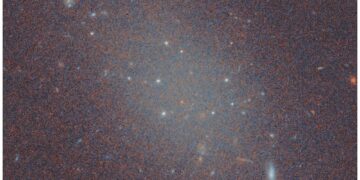Galaxies without dark matter were once the stuff of scientific fiction. But the discovery of FCC 224, an ultra-diffuse galaxy (UDG) captured by the Hubble Space Telescope, is reshaping how we think about the universe. FCC 224 is not just an oddity; it could force astronomers to rethink the very blueprint of galaxy formation. Its ghostly glow, weak gravitational pull, and faint spread of stars are raising profound questions about what truly holds galaxies together—and whether dark matter is as essential as we thought.
FCC 224 and the Mystery of Ultra-Diffuse Galaxies
Ultra-diffuse galaxies (UDGs) like FCC 224 are cosmic wisps—large like the Milky Way but containing far fewer stars. FCC 224 stands out because it defies the basic rule that UDGs need lots of dark matter to exist. Normally, dark matter acts like an invisible glue, binding the few visible stars tightly enough to keep the galaxy from drifting apart. But detailed observations of FCC 224 show that its stars are held together by much less mass than expected.
Evidence for this comes from a detailed study led by astronomers using Hubble and ground-based observatories. FCC 224’s low surface brightness, combined with the motion of its stars and globular clusters, shows a startling lack of the gravitational pull usually attributed to dark matter. If dark matter isn’t doing the heavy lifting here, something else must be at play—or our understanding of galaxy dynamics could be wrong.
This discovery is crucial because it adds another piece to the growing puzzle created by other similar finds, like the famous dark matter-deficient galaxies NGC 1052-DF2 and DF4. FCC 224 is not an isolated case—it is part of an emerging pattern.
Globular Clusters: Clues Hidden in the Ancient Star Systems
One major clue that FCC 224 lacks dark matter comes from its globular clusters—ancient, densely packed star systems orbiting galaxies. In FCC 224, these clusters are small, luminous, and tightly grouped, behaving in a way inconsistent with a high dark matter environment.
A research team analyzed the velocity dispersions (the range of speeds at which stars move) of these globular clusters and found that they orbit with speeds much slower than expected if dark matter were abundant. If a galaxy was stripped of its dark matter violently, through a collision, for example, the globular clusters would also show signs of disruption. But FCC 224’s clusters remain compact and orderly, suggesting that no such violent event occurred.
This evidence is critical because it debunks one of the main theories explaining dark matter-free galaxies: collision and stripping. Without signs of chaos in the clusters, the collision model becomes highly unlikely. Therefore, FCC 224 might have always lacked dark matter—or formed differently than anything we’ve previously imagined.
A New Category of Dark Matter-Free Galaxies
FCC 224 doesn’t just stand alone; it may belong to a new class of galaxies altogether. Research led by Maria Luisa Buzzo and Yimeng Tang shows that galaxies like FCC 224 share similar characteristics: old, metal-poor stars, low dust content, slow rotation, and unusually stable globular cluster systems. These common traits suggest that dark matter-deficient galaxies aren’t just cosmic accidents—they could be a recognized population.
Finding multiple galaxies that defy dark matter expectations strengthens the case that the ΛCDM (Lambda Cold Dark Matter) model—the backbone of modern cosmology—might be missing key ingredients. If dark matter isn’t needed to form or sustain all galaxies, what does that mean for our current models?
This is incredibly important because the ΛCDM model is based on the premise that dark matter’s gravitational influence is critical for galaxy formation and cosmic structure.
Dark Matter, Modified Gravity, and the Future of Cosmology
If galaxies like FCC 224 can exist without dark matter, two big possibilities emerge: either dark matter isn’t as critical as we think, or our understanding of gravity at galactic scales is incomplete. Some researchers propose that modified gravity theories, such as Modified Newtonian Dynamics (MOND), could better explain the behavior of such galaxies.
In MOND-like theories, the force of gravity changes under very low acceleration conditions, like those present in ultra-diffuse galaxies. Such models could explain FCC 224 without invoking dark matter. While these theories remain controversial, the repeated discovery of dark matter-deficient galaxies makes it harder to dismiss them outright.
The importance of FCC 224 is that it strengthens the need for alternative thinking. Either dark matter is more complex than we realize, perhaps interacting differently in certain environments, or we need new physics to explain these ghostly galaxies.
Future Research: Unlocking the Secrets of FCC 224
The discovery of FCC 224 sets the stage for new astronomical surveys and theoretical models. Telescopes like the James Webb Space Telescope (JWST) and the upcoming Vera C. Rubin Observatory will search for more ultra-diffuse galaxies, testing whether dark matter-deficient systems are rare exceptions or common occurrences.
Simultaneously, cosmologists will refine simulations to include scenarios where dark matter isn’t the dominant force, and astronomers will measure star motions more precisely to better estimate mass distributions. By combining observations with fresh theoretical work, the scientific community hopes to uncover how FCC 224 and similar galaxies truly formed.
Importantly, researchers will need to probe these galaxies across different wavelengths—infrared, radio, and X-ray—to search for hidden clues about their origin stories, stellar populations, and possible past interactions.
Conclusion: Why FCC 224 Matters for All of Us
FCC 224 is more than a curiosity—it is a flashing signal that something fundamental about our universe might be missing from our current theories. Whether this leads to the confirmation of modified gravity, a revolution in dark matter theory, or the discovery of new cosmic phenomena, FCC 224 has already made history.

















